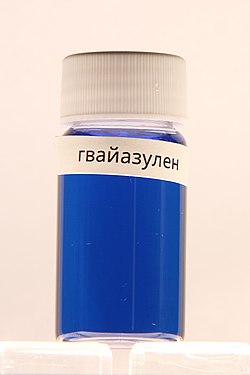 | |
| Names | |
|---|---|
| Preferred IUPAC name 1,4-Dimethyl-7-(propan-2-yl)azulene | |
| Identifiers | |
3D model (JSmol) | |
| 1365001 | |
| ChEBI | |
| ChEMBL | |
| ChemSpider | |
| DrugBank | |
| ECHA InfoCard | 100.007.002 |
| EC Number |
|
| KEGG | |
PubChem CID | |
| UNII | |
CompTox Dashboard (EPA) | |
| |
| |
| Properties | |
| C15H18 | |
| Molar mass | 198.309 g·mol−1 |
| Density | 0.976 g/cm3 |
| Melting point | 31 to 33 °C (88 to 91 °F; 304 to 306 K) |
| Boiling point | 153 °C (307 °F; 426 K) (7 mm Hg) |
| Pharmacology | |
| S01XA01 ( WHO ) | |
Except where otherwise noted, data are given for materials in their standard state (at 25 °C [77 °F], 100 kPa). | |
Guaiazulene, also azulon or 1,4-dimethyl-7-isopropylazulene, is a dark blue crystalline hydrocarbon. A derivative of azulene, guaiazulene is a bicyclic sesquiterpene that is a constituent of some essential oils, mainly oil of guaiac and chamomile oil, which also serve as its commercial sources. Various soft corals also contain guaiazulene as a principal pigment. [1] Its low melting point makes guaiazulene difficult to handle, in contrast to the crystalline nature of the parent azulene. The electronic structure (and colors) of guaiazulene and azulene are very similar.

